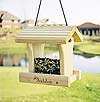| Location, Location, Location! There are a few key points to consider when deciding where to put your feeder. It's not as simple as hanging it from the nearest tree: You want to think about things like avoiding competition and accommodating various feeding styles and preferences. You also want to think of possible hazards to the birds, such as window collisions, prowling cats, and thieving squirrels. Follow these tips to provide an ideal environment in your backyard. |
| Locate feeders at different levels. Sparrows, juncos, and towhees usually feed on the ground, while finches and cardinals feed in shrubs, and chickadees, titmice, and woodpeckers feed in trees. To avoid crowding and attract the greatest variety of species, provide table-like feeders for ground feeding birds, hopper or tube feeders for shrub and treetop feeders, and suet feeders well off the ground for woodpeckers, nuthatches, and chickadees. |
 |
| Protect birds from window collisions. In the United States, approximately 1 billion birds die from flying into windows each year. Protect birds from collisions by placing feeders within three feet of windows, if possible. Mobiles and opaque decorations hanging outside windows help to prevent bird strikes, or attach fruit tree netting outside windows to deflect birds from the glass. |
 |
|
Keep cats indoors. The location of your feline friends is important, too. Cats kill hundreds of millions of birds annually in the United States, often pouncing on ground-feeding birds and those dazed by window collisions. Responsible and caring cat owners keep their cats indoors, where they are also safer from traffic, disease, and fights with other animals. Outdoor cats are especially dangerous to birds in the spring when fledglings are on the ground. Bells on cat collars are usually ineffective for deterring predation.
Credits to National Audubon Society |
 |